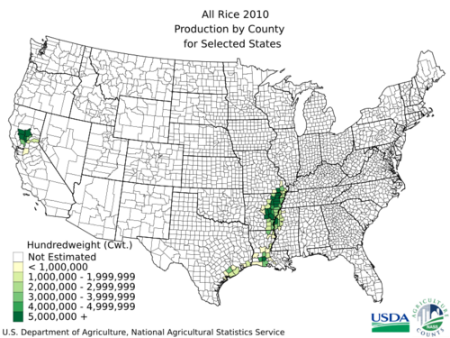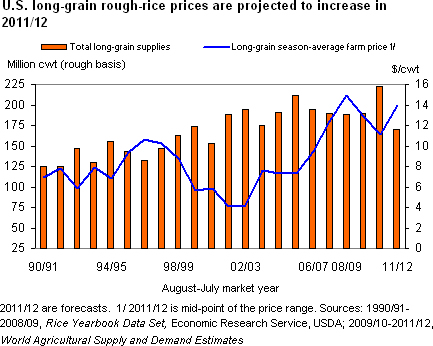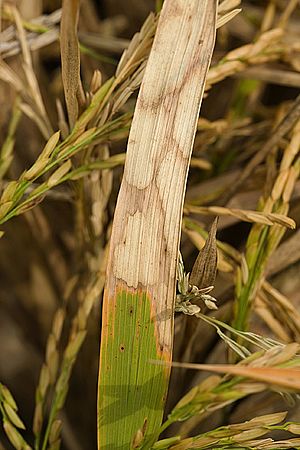Rice cultivation in Arkansas facts for kids
Rice production in Arkansas is a really big deal! It became a major industry in the late 1800s and early 1900s, thanks to a person named W.H. Fuller around 1896. Arkansas has always been the biggest rice producer in the entire United States. In 2001, it grew almost 45% of all the rice in the U.S. and harvested nearly half of the total rice fields nationwide.
Most of Arkansas' rice grows in the east-central part of the state. Rice needs a lot of water, about three times more than the average rainfall this region gets during the growing season. Farmers often rotate their crops to keep the soil healthy and manage weeds. Many Arkansas rice farmers plant rice after growing soybeans.
Contents
How Rice Farming Started in Arkansas
The story of rice farming in Arkansas, especially in the Grand Prairie area, often begins with W.H. Fuller. He was an entrepreneur from Nebraska who moved to Lonoke County, Arkansas. He started planting rice all over the region.
Fuller got the idea to plant rice in Arkansas in August 1896. He was on a hunting trip to Louisiana with his friend Hewit Puryear. As they traveled by horse and wagon, they were amazed by a rice field in a town called Crowley. Fuller realized, "We had a good rice country if we had the water." He thought about using wells for water, just like people were starting to do near Crowley.
Fuller had some early success, but he soon realized he needed to learn more about growing rice. So, in 1898, he went back to Louisiana with another farmer, John Morris, to learn the best techniques. Fuller returned to Arkansas in 1903 as a master rice farmer. In 1904, he planted many acres of rice and harvested over 5,000 bushels!
Rice and Arkansas's Economy
The yearly rice crop in Arkansas is super important for the state's economy. It adds more than $6 billion to Arkansas's economy every year! Plus, it creates over 25,000 jobs.
Many things can affect how much profit Arkansas rice farmers make. For example, the prices farmers get for their rice in the U.S. are connected to prices around the world. Also, payments from the government can help farmers. These payments often encourage certain farming methods, like mixing different crops to reduce risks.
The money farmers earn from rice crops in Arkansas can change a lot. It depends on the type of rice grown, how crops are rotated, where in the state the rice is grown, and the farming methods used. For instance, growing rice continuously (without rotating other crops) often brought in the most money per field between 2000 and 2001.
Where Rice Grows in Arkansas
Arkansas is the biggest rice-producing state in the U.S. It plants more acres of rice and produces more rice than any other state. In 2003, Arkansas had 1,466,600 acres planted with rice. To compare, California and Louisiana, the next biggest rice states, had much less: California had 509,000 acres, and Louisiana had 455,000 acres in the same year.
In 2003, the five counties in Arkansas that grew the most rice were:
- Poinsett County
- Arkansas County
- Cross County
- Jackson County
- Lawrence County
These five counties alone grew almost 36% of all the rice in Arkansas!
How Rice is Grown
Using Technology for Irrigation
Rice needs a lot of water, so farmers have to bring in extra water for their fields. However, Arkansas rice growers are using smart ways to save water. They use natural slopes and soil depths to keep water in the fields. One method that more and more farmers are using is called "straight-levee rice cultivation."
Other common ways to water rice fields include using floods and levees. In 2003, about 75% of all rice fields were watered this way. Another method, called flood/multiple inlets, was used for about 25% of the fields.
Planting Rice Seeds
In Arkansas, rice is usually planted in rows using a drill. The fields are then flooded when the rice plants have four to six leaves, which is usually four to five weeks after planting. This is called a "dry seeded culture."
Many Arkansas rice farmers still use traditional methods to prepare their fields for planting. For example, farmer Dow Brantley from England, Arkansas, said in 2005 that he still plants about 20% of his rice using these older methods. However, he plants most of his rice using "no-till" methods. He has found that "reduced till rice" has many benefits. These include lower costs, more profit per acre, less work for farmers, less wear and tear on equipment, and fewer problems with certain weeds.
Adding Nutrients to the Soil
Just like with many crops, how much and what kind of fertilizer is used for rice in Arkansas can change based on many things. Nitrogen fertilizer is very important for rice growth. The University of Arkansas Division of Agriculture (U.A.D.A.) gives advice on how much nitrogen to add. This advice depends on the type of soil, the kind of rice being grown, and what other crops were planted before.
For example, for Wells rice grown after soybeans in silt or sandy-loam soils, the U.A.D.A. suggests a certain amount of nitrogen. But if the soil is clay instead of silt/sandy-loam, they recommend adding more nitrogen.
Types of Rice Grown in Arkansas
The most common types of rice planted in Arkansas, and how much of the total rice land they cover, are:
- Wells (45.2%)
- Cocodrie (21.8%)
- Bengal (11.2%)
- Francis (6.3%)
- CL 161 (4.7%)
- LaGrue (2.6%)
Wells rice is the most popular type. It's a long-grain rice that was created by the Arkansas Agricultural Experiment Station in 1999 to help farmers grow more rice. Even though Wells rice is very common, "Bengal is a successful medium-grain rice released in 1993 and is still the leading medium-grain variety grown in Arkansas."
Challenges: Weeds and Pests
Rice farming in Arkansas faces threats from different diseases and pests. One problem is a fungus called Pyricularia grisea, also known as rice blast. This fungus spreads mainly from infected rice plants left over from the year before, or even sometimes from infected seeds. While outbreaks of this fungus can be random, "rice blast has caused significant yield losses in Arkansas."
Another disease, called sheath blight, is also very important. It's caused by something in the soil. The first signs of sheath blight usually appear as spots on the lower leaves of the rice plants.
The weed that causes the biggest problems for Arkansas rice is barnyard grass. This is because it has become resistant to two common herbicides that farmers use. Also, "weedy red rice (Oryza sativa) is a problematic weed in cultivated rice." About 60% of Arkansas's rice fields have some red rice growing in them. Weeds like barnyard grass and weedy red rice can really hurt rice fields. In 1992, they caused over $22 million worth of crop losses!




